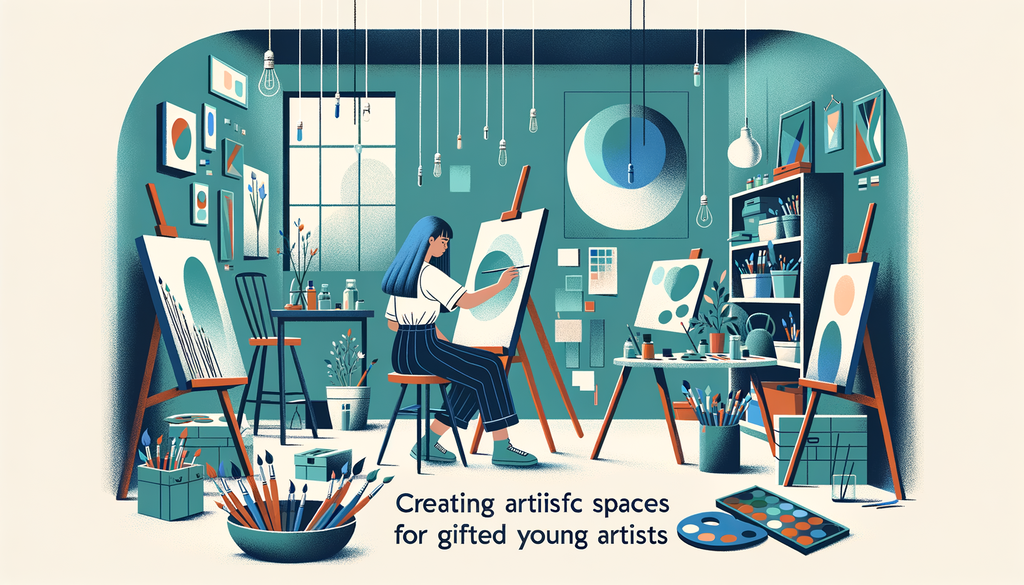Creating Artistic Spaces for Gifted Young Artists

Creating Artistic Spaces for Gifted Young Artists
Art, in its varying forms, provides an excellent outlet for the curious minds of gifted children. As highly imaginative and creative individuals, gifted children can flourish, astound, and express their deeper perceptions of the world through the arts. The potential impact of a well-designed and supportive art program can be game-changing. This blog will explore the role of art programs and provide resources for harnessing the artistic skills of your gifted child.
Why Focus on Art?
Seamlessly integrating elements of cognitive, socio-emotional, and motor skill development, artistic engagement is uniquely positioned to enrich gifted children’s overall intellectual growth. Art programs allow gifted children to dive into their worlds, providing space for independent exploration and self-expression. Creative pursuits can also foster an incredible resilience, as they often involve trial and error, experimentation, and divergence from norms and expectations.
In addition, participation in art can serve as a form of emotional release and self-regulation for gifted children who may have heightened emotional sensitivity. As we’ve explored in the post on Managing Meltdowns, helping gifted children develop coping strategies for their emotional intensity is crucial for their mental and emotional well-being.
Locating Artistic Opportunities
Recognizing the importance of art is just the first step. The next is to locate the right opportunities to nourishing budding artists. Here are a few places to consider:
-
Community Arts Programs: Local communities typically offer a range of artistic programs aimed at children and teenagers. These could be anything from painting classes, pottery workshops, theater groups, or music lessons. Ranging from those that cater to Musical Talents, to visual and performing arts, these programs provide valuable avenues for creativity and enjoyment.
-
Arts-Based Schools and Camps: Certain schools and camps focus specifically on the arts and can be an invaluable resource for gifted artists. These include programs like Interlochen Center for the Arts or the Savannah College of Art and Design pre-college summer programs.
-
Online Art Resources: With the rise of digital learning platforms, there’s an abundance of online art resources available. Websites such as Art For Kids Hub or YouTube channels like Proko provide easily accessible content that can help children explore various artistic styles and techniques at their own pace.
The key is to find a program that matches the child’s interests and provides the right balance of structure and freedom to allow their creativity to thrive. It’s crucial to remember that the goal isn’t to create a ‘perfect piece’ but rather to enjoy the process of creation – this perspective can be especially affirming for gifted learners, who may sometimes struggle with feelings of perfectionism.
Nurturing the Artist at Home
Incorporating art into the home environment can also be a valuable approach in nurturing your child’s artistic abilities. You can foster a creative atmosphere by:
-
Creating an Art Corner: Set aside a designated area where your child can indulge in his/her creative pursuits. Make sure this space is well-stocked with different art supplies, and allows for exploration and mess!
-
Exposing to Different Art Forms: Also, expose them to different types of art forms- from classical paintings and modern sculptures, to indie music and Broadway shows. This broad exposure can inspire children and expand their understanding of what ‘art’ can be.
-
Encouraging Their Voice: Lastly, nurture the unique voice of your child. Appreciate their homegrown projects, encourage originality, and allow them to explore their personal style. Remember, it’s their artistic journey; your role is to support and provide resources, not to dictate the path.
Even as we present you with these tips, we caution against over-scheduling or pressurizing a child’s art journey. As discussed in “Easing Into Education: Transitional Strategies for Special Needs Kids”, it is important to keep the learning journey flexible and responsive to the child’s needs.
Conclusion
Nurturing the artistic talents of gifted children can set them on a path of fruitful exploration, self-discovery, and personal growth. By inspiring them with rich artistic experiences, creating supportive environments, and providing access to various art resources, we can empower them to unleash their creativity and make a beautiful mark on the world.
So are your brushes ready, your music notes lined up, and your clay waiting to be shaped? Let’s dive in and color the world with our imagination!